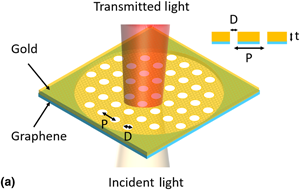Article contents
Enhanced light-matter interactions in size tunable graphene–gold nanomesh
Published online by Cambridge University Press: 20 December 2019
Abstract

A hybrid graphene–gold nanomesh, realized through Au deposition on a patterned graphene nanomesh with a focused ion beam, is introduced and illustrated for enhanced light absorption in the visible spectrum. Numerical studies reveal that the hybrid nanomesh with dual resonances in the visible spectrum exhibit ~50% light absorption and enhancement factor as high as ~1 × 108. The simulations also show that the enhanced optical absorption is associated with the excitation of surface plasmons. This is confirmed through the localization of electric fields at the resonant wavelengths. Such a hybrid graphene–gold nanomesh exhibiting enhanced light-matter interactions paves the way toward plasmonics, surface-enhanced Raman scattering applications, etc.
Information
- Type
- Research Letters
- Information
- Copyright
- Copyright © Materials Research Society 2019
References
- 4
- Cited by


